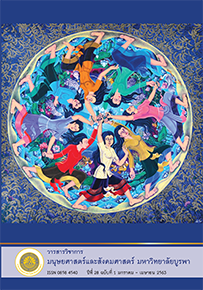Readiness and Developing Plan of Monasteries for Ageing Society in Chonburi Province
Main Article Content
Abstract
This research article consisted of three objectives: 1) to study the readiness of monasteries in responding to the ageing society, Chonburi Province, 2) to find out the guidelines for the development of monasteries, and 3) to set up a development plan of monasteries. The research method was based on a qualitative technique. Ninety-five key informants were purposively selected from each monastery of 11 districts and 1 special administrative region in Chonburi Province. The data were collected through the semi-structured in-depth interview and analyzed by frequency, percentage and content analysis.
The results were as follows: 1) Readiness of monasteries in responding to the ageing society including six factors i.e. car parking place/area, stairs/sidewalks, toilets/rest rooms, chairs/seats, teaching billboards/signs, and others was at the lowest level, and then these factors, especially teaching billboards/signs needed to be developed the most. 2) Guidelines should be composed of five parts i.e. who, what, when, how and where (budget), consented with the National Strategic Plan for Reforming Affairs of Buddhism, concerning with the Global Age-Friendly Cities: A Guide as well as the idea of Universal Design. 3) The development plan was the short term/urgent agenda which ought to be finished within one year; the things to be developed were teaching billboards/signs, toilets/rest rooms and stairs/sidewalks, and the major participants were lay devotees, Buddhist monks/Monasteries and community leaders; the budgets should be derived from lay devotees, governmental sectors and community leaders; and the key informants revealed that physical participation and public relations were the things that they provided to the monasteries the most.
Downloads
Article Details
บทความทุกบทความเป็นลิขสิทธิ์ของวารสารวิชาการมนุษยศาสตร์และสังคมศาสตร์ มหาวิทยาลัยบูรพาเท่านั้น
References
กฎกระทรวงกำหนดสิ่งอำนวยความสะดวกในอาคารสำหรับผู้พิการหรือทุพพลภาพและคนชรา พ.ศ. 2548. (เล่มที่ 122 ตอนที่ 52 ก.). (2548, 2 กรกฎาคม). ราชกิจจานุเบกษา. หน้า 4-19.
กรมอนามัย กระทรวงสาธารณสุข. (2557). คู่มือการดำเนินงานเมืองที่เป็นมิตรกับผู้สูงอายุ (Global Age-Friendly Cities: A Guide). กรุงเทพฯ: สำนักกิจการโรงพิมพ์การสงเคราะห์ทหารผ่านศึก.
กองพุทธศาสนสถาน สำนักงานพระพุทธศาสนาแห่งชาติ. (2554). คู่มือการพัฒนาวัดสู่ความเป็นมาตรฐาน. ม.ป.ท.
กองส่งเสริมและพัฒนาการจัดการศึกษาท้องถิ่น กรมส่งเสริมการปกครองท้องถิ่น กระทรวงมหาดไทย. (2561). คู่มือการดำเนินงานโครงการวัด ประชา รัฐ สร้างสุข: พัฒนาวัดตามแนวทาง 5 ส. ที่ทุกภาคส่วนมีส่วนร่วมขององค์กรปกครองส่วนท้องถิ่น. สิ่งที่ส่งมาด้วย ที่ มท 0816.3/ว 2206 ลงนามโดยอธิบดีกรมส่งเสริมการปกครองท้องถิ่น.
สมาคมสถาปนิกสยาม ในพระบรมราชูปถัมภ์. (2557). ข้อแนะนำการออกแบบสิ่งอำนวยความสะดวกสำหรับทุกคน (Buildings and Environments Design Recommendation for All). กรุงเทพฯ: พลัสเพรส.
สำนักงานกองทุนสนับสนุนการสร้างเสริมสุขภาพ (สสส). (ม.ป.ป.). คู่มือมือบ้านใจดีบ้านที่ออกแบบเพื่อทุกคน (Universal Design Home). ม.ป.ท.
สำนักงานจังหวัดชลบุรี. (ม.ป.ป.). แผนพัฒนาจังหวัดชลบุรี (พ.ศ. 2557-2560) ฉบับทบทวนรอบปี 2560. ม.ป.ท.
เสาวภา พรสิริพงษ์, ขวัญจิต ศศิวงศาโรจน์ และยงยุทธ บุราสิทธิ์. (2557). วัดในพุทธศาสนากับความพร้อมในการรองรับสังคมผู้สูงอายุ. วารสารภาษาและวัฒนธรรม, 33(1), 99-125.
หน่วยปฏิบัติการวิจัยสภาพแวดล้อมที่เหมาะสมกับผู้สูงอายุ คณะสถาปัตยกรรมศาสตร์ จุฬาลงกรณ์มหาวิทยาลัย. (ม.ป.ป.). ข้อแนะนำการออกแบบสภาพแวดล้อมและที่พักอาศัยของผู้สูงอายุ. กรุงเทพฯ: กระทรวงการพัฒนาสังคมและความมั่นคงของมนุษย์.
Center for Inclusive Design and Environmental Access. (2012). The Goals of Universal Design. Retrieved from en.m.wikipedia.org.


